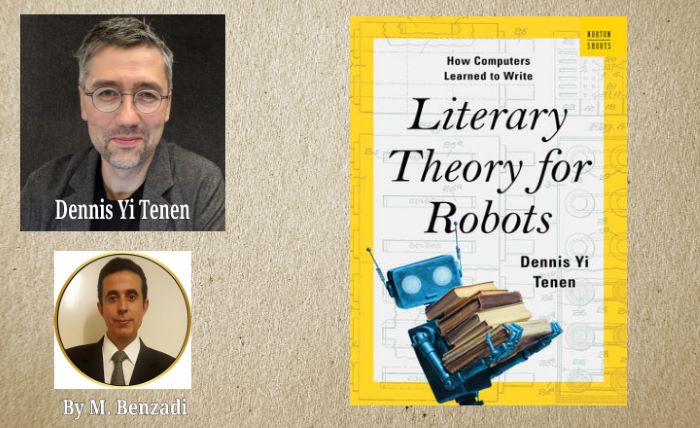“How Computers Learned to Write: Literary Theory for Robots”
A Comprehensive Overview of AI Concept and History
In just under 200 pages, Dennis Yi Tenen delivers an impressively comprehensive overview of the history and evolving concept of artificial intelligence (AI) in his new book titled "How Computers Learned to Write: Literary Theory for Robots." He traces the development of the field back centuries, exploring philosophical and technological precedents that have helped shape this revolutionary technology. Along the way, he raises thought-provoking questions about the nature, opportunities, and limitations of intelligence itself.
Early Foundations And Inspirations Of AI
Tenen opens his book by challenging the commonly held belief that there is a clear distinction between human and artificial intelligence. He argues that the definition of intelligence found in dictionaries supports his viewpoint. According to him, none of the boundaries between human and artificial intelligence are convincing. To support this, he refers to Webster’s dictionary, which defines intelligence as the "skilled use of reason." He explains that the term "artifice" stems from the Latin words ars (skilled work) and facere (to make), indicating that "artificial" intelligence simply means the combination of reason and skill. Therefore, there are no strict boundaries, only a synergy between the human mind and its technological extensions.
Tenen believes that a more comprehensive understanding of AI should be rooted in the history of the humanities. He asserts that technologies like chatbots, search engines, and language processing tools have their origins in long-standing traditions of symbol manipulation and language processing techniques that have existed for centuries.
In support of his argument, Tenen highlights the historical connection between humans and machines. He emphasizes that throughout history, humans have been thinking in collaboration with machines, just as machines have been thinking in collaboration with humans. He asserts that the mind, hand, and tool move in unison. The early pioneers of logic and mathematics played a significant role in the development of artificial intelligence. Figures such as Aristotle worked on describing logical systems using syllogisms - logical arguments with two premises and a conclusion. Later logicians such as Gottfried Leibniz and George Boole introduced formal logic systems based on binary true/false values and algebraic operations, laying the foundation for computational processing and the eventual emergence of AI. Tenen also references ancient divination charts, the rotating paper charts created by Ramon Llull in the 13th century (which could be considered early "chatbots"), and John Wilkins' 1668 proposal for a philosophical language aimed at facilitating cross-cultural translation as examples of historical influences on AI.
Ibn Khaldun’s Contributions to AI
Tenen explores the historical origins of the idea of universal languages and machines capable of automated language production and reasoning. He traces back this concept to medieval divination wheels and credits the Arabic scholar Ibn Khaldun for his significant contribution in the form of the zairajah device.
Ibn Khaldun, a well-known scholar and historian, documented advanced computational techniques, including the zairajah, which laid the foundations for artificial intelligence. In his book "Muqaddimah," Ibn Khaldun detailed the complex methods used by skilled individuals to gain insights into the unknown based on known information. These techniques involved numerical conversions, chart consultations, and intricate processes. The use of the zairajah by soothsayers demonstrated early forms of automated reasoning, prediction, and decision-making, which are fundamental to artificial intelligence. By delving into these sophisticated divination methods, Ibn Khaldun provided valuable insights into the fusion of human intellect and technological processes, paving the way for the development and understanding of artificial intelligence concepts.
AI's Growing Reach Across Applications and Industries
AI has rapidly evolved, becoming a mainstream technology that is transforming various industries. Assistive AI is making significant advancements in fields such as healthcare, education, and accessibility by providing personalized screening, tutoring, and live captioning services. AI is now ingrained in our daily lives, powering search engines, recommendation systems, and customer service chatbots. It has become a crucial tool in flagging offensive content on social networks and filtering spam from our inboxes.
In the healthcare sector, AI helps convert patient-doctor conversations into insurance billing codes and can even predict potential terrorist plots or violence on social media platforms. Legal professionals rely on AI to uncover evidence of corporate fraud, and students are now using AI-powered smart word processors to generate entire essays on any topic. The application of AI is not limited to the professional world; even mundane tasks such as sanitation work benefit from AI's ability to transform data.
Online shopping has been revolutionized by AI, with chatbots taking on customer service, administrative, and even therapeutic roles. Facial recognition tools have become prevalent at major airports, enhancing security and assisting law enforcement agencies. AI-augmented analytics offer new insights in medicine and enable precision agriculture through advanced forecasting and automated monitoring. In fact, an AI artist has even created portraits so realistic that they fooled art experts, and literary bots can generate thought-provoking poetry and prose. AI has even advanced to the point where computers can engage in conversation, providing company, sharing ideas, giving advice and even making jokes.
The economic contributions of AI have also skyrocketed alongside its capabilities and widespread adoption. It is estimated that by 2030, AI will contribute an annual boost of $15.7 trillion to the global GDP, resulting in a 26% increase in real income per capita worldwide. This growth will be driven by more productive workers, higher consumer surplus through improved products and services, and eco-friendly optimization techniques that help moderate carbon footprints. As AI continues to evolve, it is clear that this once-narrow academic concept has become a dominant paradigm that will shape humanity's future in both beneficial and potentially concerning ways.
The Social and Economic Risks of AI Systems
Alongside boundless opportunities, there are serious disadvantages and threats that accompany the rise of artificial intelligence technologies. Perhaps the greatest challenge is that AI systems are at risk of amplifying existing social biases if they are trained on data that reflects real-world biases and inequalities. This could spread and normalize harmful stereotypes. Additionally, the distributed and collaborative nature of modern AI makes it difficult to clearly assign responsibility and accountability when systems make mistakes or harmful decisions. A recent example of this was the "Jake Moffat Air Canada case" reported by the Washington Post. In this case, Jake Moffatt, a resident of British Columbia, purchased a flight ticket from Air Canada’s website using their chatbot's assistance. The chatbot wrongly informed him that he was eligible for a discount under the airline’s bereavement policy. When Moffatt tried to claim the discount later, he found out that the chatbot’s information was incorrect. Air Canada argued that the chatbot was a separate legal entity responsible for its actions. Moffatt filed a claim with a Canadian tribunal, which ruled in his favor, stating that Air Canada did not ensure the accuracy of its chatbot. The tribunal ordered Air Canada to pay Moffatt over $600 in damages and fees.
From an economic perspective, as automation increasingly allows for the digitization of knowledge work, there is a threat that many jobs will be displaced, leaving workers without livelihoods. Furthermore, a frequentist and probabilistic understanding of language through AI may isolate human intelligence and limit its ability to continue evolving in response to ongoing historical and social changes. Although still hypothetical, sufficiently powerful generalized AI could hypothetically pose severe existential risks to humanity if such systems were able to autonomously improve themselves in uncontrolled ways without adequate safeguards.
Shaping the Future of AI
Another disadvantage of AI is the tendency for humans to become overly dependent on it. For instance, students no longer make an effort in writing essays as AI can generate them in seconds. The author warns that "We should be preparing for a future where 'writers' and 'coders' are incapable of authoring a single line unassisted." These challenges highlight the disadvantages that must be addressed to ensure AI has a positive impact on society.
The future of AI appears uncertain but holds the potential to profoundly transform societies, economies, and daily lives, for better or worse depending on how developments are consciously guided. Well-regulated progress that enhances humanity's capabilities while mitigating harms presents both an opportunity and an obligation that is worth continued focus across fields, from engineering to ethics. With diligent effort, many experts argue that AI may ultimately prove to be the most empowering general-purpose technology developed by our species if handled judiciously and for the common good. And if AI is misused by people, we should not blame the technology itself but hold the individuals responsible for their actions. The author argues, "Yet, we must insist on holding bad actors responsible for their actions, rather than excusing their actions by shifting blame to the technology."



